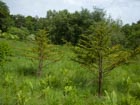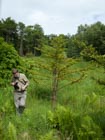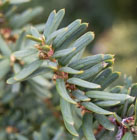Conservation Status

(var. cuspidata)

(var. nana)
Taxus cuspidata
Siebold et Zuccarini 1846
Common names
Japanese yew; イチイ, inchii, onko [Japanese]; var nana is called kyaraboku.
Taxonomic notes
The hybrid T. baccata × T. cuspidata is T. × media (Hils 1993). There are two recognized varieties:
T. cuspidata var. cuspidata. Syn:
- T. baccata L. var. cuspidata (Sieb. & Zucc.) Carr.;
- T. baccata L. subsp. var. cuspidata (Sieb. et Zucc.) Pilg.;
- T. baccata L. var. microcarpa Trautv.;
- T. cuspidata Sieb. & Zucc. var. microcarpa (Trautv.) Kolesn.;
- T. cuspidata Sieb. & Zucc. var. umbraculifera (Sieb. ex Endl.) Makino;
- Cephalotaxus umbraculifera Sieb. ex Endl.;
- T. cuspidata Sieb. & Zucc. var. latifolia (Pilg.) Nakai) (Farjon 1998).
T. cuspidata var. nana hort. ex Rehder (syn: T. cuspidata f. nana) (Farjon 1998).
Ohwi (1965) also describes a var. luteobaccata Miyabe & Tatew. (Jap.: KIMI-NO-ONKO) with a yellow aril.
Description
Tree: Erect, to 16 m tall with a pyramidal form (Hartzell 1991). Branches: Spreading or ascending (Ohwi 1965). Shoots: Red-brown (Hartzell 1991). Leaves: Spirally arranged, appearing 2-ranked, linear, 15-25 × 2-3 mm, abruptly narrowed to a short spinescent apex, abruptly short-petiolate at base, dark green with a prominent midrib on the dorsal surface when dry, the ventral side with 2 wide tawny stomatal bands. Cones: Aril red when ripe (Ohwi 1965). See García Esteban et al. (2004) for a detailed characterization of the wood anatomy.
Var. nana is a low shrub with ascending, densely arranged branches, leaves not appearing 2-ranked; native to Japan Sea side of the mountains in Honshu (Ohwi 1965).
Distribution and Ecology
N Korea; China: Heilonjiang, Jilin, Nei Mongol, Liaoning, Hebei, Shaanxi, and Shanxi; Russia: E and S from the Amur R. basin (incl. Sakhalin I. and Kurile Is.); Japan: Hokkaido, Honshu, Shikoku and Kyushu. (Hartzell 1991, Farjon 1998). Hardy to Zone 6 (cold hardiness limit between -23.2°C and -17.8°C) (Bannister and Neuner 2001). Exploitation has rendered it rare in much of its range.
Distribution data for all species native to east Asia and Malesia, from Conifers of the World, downloaded on 2018.01.26.
Remarkable Specimens
"A tree in Kedrovaya Pad Nat. Res., in S Ussuriland, is 2.8 m dbh and 15 m tall. Another one on Shikotan Isl., Kuril Islands, is 20 m tall, 50-60 cm dbh" (Vladimir Dinets e-mail 1998.01.10). Ernest Henry Wilson in 1916 reported that the largest specimens he encountered were in the Diamond Mountains of central Korea and reached 18 m tall, 97 cm dbh, "with large spreading branches forming handsome crowns" (Hartzell 1991).
The oldest reported living tree was 949 years old (partially crossdated) in 2012, growing on Laoyeling in Jiling at 950 m elevation (Liu et al. 2019, citing Zhang 2012).
Ethnobotany
A common ornamental in Japan (particularly var. nana (Ohwi 1965)) and also in the West since its introduction to the U.S. in 1833. Readily shaped into hedges and topiary, and said to be the hardiest, fastest-growing and easiest to cultivate of all yews. In Japan, it was formerly valued for piles and foundations, cabinetry, finish carpentry, woodcarving, water tanks, pails, bathtubs, trays, chopsticks, clogs, and for bows (for which it was also used by the Ainu). Medicinally it was used as an abortifascient and antidiabetic. Commercial use has greatly declined in recent decades due to overexploitation (Hartzell 1991).
Observations
No data as of 2023.02.23.
Remarks
The Latin epithet cuspidata refers to the small cusp at the apex of the leaves.
Citations
Liu, Jiajia, Bao Yang, and David B Lindenmayer. 2019. The oldest trees in China and where to find them. Frontiers in Ecology and the Environment 17(6): 319–22. https://doi.org/10.1002/fee.2046.
Zhang Y. 2012. 200 years of climate change recorded by tree ring of Taxus cuspidate. MSc thesis,
Northeast Forestry University.
See also




